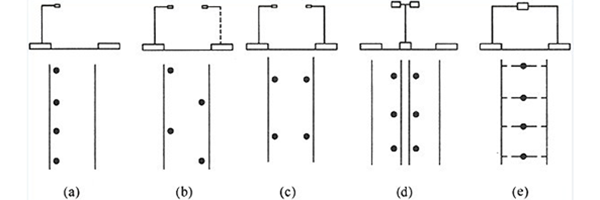In the EMC project, the general government or the manufacturer will mention the implementation of the test section in the business negotiation with the government. What are the selection requirements for the test section? How can we implement a test road section that is qualified and satisfactory to the local government? Let’s discuss it here.
First of all, the typical road sections with representative characteristics in terms of spacing, height, overhang, elevation and consistency of light sources should be selected for the test section.
1. Spacing
It is better to keep the distance between street lamps as small as possible. The preferred distance is not more than 40m. It is better to choose the road with 35m pole distance. National standard CJJ45-2006 Standard for Lighting Design of Urban Roads (reference value of street lamp spacing): the spacing is about 3 times of the height of the cut-off lamp pole itself, and straight roads are selected instead of curves or intersections. The cantilever length of the lamp should not exceed 1/4 of the installation height, and the elevation angle of the lamp should not exceed 15 °.
2. Road width
The road width is preferred to be two-way four lane (about 15m), and the road surface is flat and wide.
3. Height of lamp pole
The preferred height of the lamp pole is 8-10 meters, and the second is not more than 12 meters (the pole height directly affects the angle of light emission and the uniformity of illumination). The diameter of the cantilever hole of the lamp is ¢ 60 mm.
Reference to national road standards:
The relationship between the light distribution type and layout of lamps and the installation height and spacing of lamps
Note: Weff is the effective width of pavement (m).
You need to pay attention to the above table. Here is the key point. As the country has issued the specifications for light distribution of street lamps, there will be differences in different test sections
Luminaire light distribution selection.
For example: a road is 18 meters wide, and the middle green belt is 2 meters long, two-way and four lane. How to judge whether the road is suitable for the test section in light pole and lamp light distribution?
The road is identified as main trunk road
1. The cut-off lamp must be used
2. According to the above table, the distribution of light poles on this road is
(1) Staggered arrangement of lights on both sides: the pole height is more than 12 meters, and the pole spacing is ≤ 36 meters, which meets the national and test section requirements.
(2) Symmetrical arrangement of lights on both sides: the pole height is more than 9m, and the pole spacing is ≤ 27m, which meets the national and test section requirements.
The road is classified as a secondary trunk road
1. Cut off or semi cut off street lamps can be used (if cut off street lamps are used, the above conditions will not change)
2. If the semi cut-off street lamp is used, the lamp pole distribution of this road is
(1) Staggered arrangement of lights on both sides: the pole height is more than 14 meters, and the pole spacing is ≤ 50 meters, which meets the national and test section requirements.
(2) Symmetrical arrangement of lights on both sides: the pole height is more than 11m, and the pole spacing is ≤ 39m, which meets the national and test section requirements.
Light distribution mode
Conventional lighting mode shall be adopted, and the layout of street lamp poles shall be symmetrical on both sides;
Selection principle sequence of light distribution mode:
Five basic methods for layout of conventional lighting fixtures
(a) One side arrangement; (b) Double side staggered arrangement; (c) Bilateral symmetrical arrangement; (d) Centrally symmetrical layout; (e) Transverse suspension cable arrangement
High pressure sodium lamp is preferred for the replaced light source: the higher the power of the light source, the better, and the single lamp power of 400W or above is preferred, followed by 250W or 150W
It is better to have few shelter and shade on both sides of the road in the test section, which will not hinder the normal lighting of the street lamps;
The secondary trunk road or branch road is preferred;
The road section with less external auxiliary light sources can reflect the lighting effect of LED street lamps.
Without any energy-saving device, the voltage is relatively stable;
Road sections with less traffic and pedestrian flow and good road conditions
In conclusion, for the street lamp energy-saving transformation project with the government department, the first consideration should be given to the energy-saving benefits of the energy consuming units, and the national standards should be strictly implemented. Secondly, we must reduce the investment risk of energy-saving service companies and recover the investment income as soon as possible. The replacement principle of all lamps must be based on these two points. Refer to CJJ45-2006 Urban Road Lighting Design Standard and GB/T 5700-2008 Lighting Measurement Method and other technical data.
Post time: Nov-01-2022


